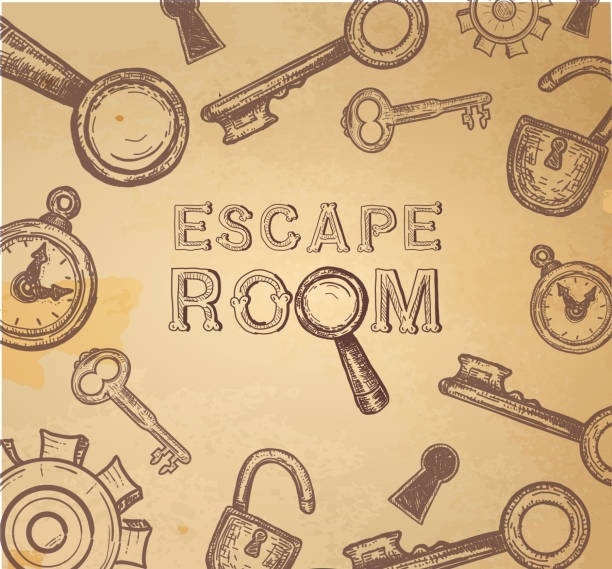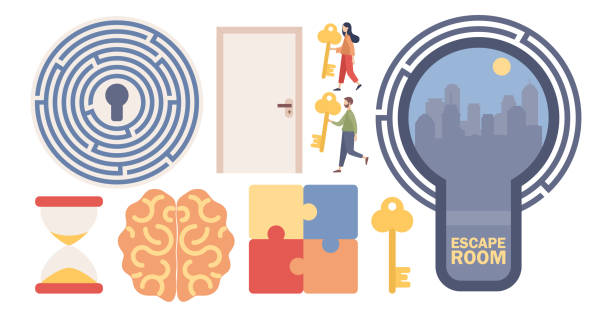How To Write A Locked Room Mystery (12 Best Tips)
How To Write A Locked Room Mystery
How To Write A Locked Room Mystery: Embark on a literary journey where the confines of space become the stage for an intricate dance between deception and deduction.
Writing a Locked Room Mystery is an art that weaves an impossible crime into the fabric of suspense, challenging both the author and the reader to navigate the labyrinth of clues within the claustrophobic confines of a singular room.
This guide is a key to unlock the secrets of crafting a compelling and enigmatic tale, where each element—from setting and characters to plot development and the final reveal—conspires to create a narrative tapestry that captivates and confounds.
Join the exploration of atmosphere, pacing, and engaging prose, where the challenge is not just to tell a story but to invite the reader into a world where the ordinary becomes extraordinary, and the locked room holds the key to unraveling an intricate puzzle of suspense.
Let the journey begin into the captivating realm of crafting a Locked Room Mystery.
How To Write A Locked Room Mystery
Certainly! Here’s a step-by-step process on How To Write A Locked Room Mystery:
Conceptualize the Locked Room Scenario
Decide on the setting for your locked room mystery. It could be a literal locked room, a sealed environment, or a situation where the victim is seemingly impossible to reach.
Create a Compelling Victim
Develop a well-rounded and interesting victim. Consider their background, relationships, and motivations. Make readers care about solving the mystery of their death.
Craft a Complex Detective or Protagonist
Introduce a detective or protagonist with unique skills or characteristics. This character will be instrumental in unraveling the mystery.
Establish a Cast of Suspects
Create a diverse group of suspects, each with plausible motives for committing the crime. Develop their personalities and relationships with the victim.
Design Clever Clues
Plan clues strategically to lead the detective and readers toward the solution. Ensure that the clues are challenging but fair, allowing the mystery to be solvable.
Build a Solid Alibi System
Establish alibis for each suspect, and make them seem airtight. The challenge lies in breaking these alibis and discovering the truth.
Integrate Red Herrings
Introduce misleading clues or red herrings to keep readers guessing. These can add complexity to the mystery and lead them down false paths.
Outline the Solution
Work out the solution to the mystery, including the method of the crime and the identity of the culprit. Ensure that it is logically consistent with the clues presented.
Write a Gripping Narrative
Begin writing the story, focusing on maintaining a suspenseful and engaging narrative. Pace the revelations strategically to keep readers hooked.
Reveal the Solution
Unveil the solution to the locked room mystery in a satisfying manner. Tie up loose ends and provide a logical explanation for how the crime was committed.
Add a Twist or Surprise
Consider incorporating a twist or surprise element to keep readers intrigued until the very end. This could involve a hidden motive or an unexpected accomplice.
Edit and Revise
Review and refine your manuscript. Ensure that the pacing is consistent, clues are well-placed, and the resolution is satisfying. Consider feedback from beta readers if possible.
By following these steps, you can create a captivating locked room mystery that challenges readers and keeps them eagerly turning the pages.

Elements of a Locked Room Mystery
Embark on a literary labyrinth where the confines of a singular space become the canvas for an enigma waiting to be unraveled—the essence of a Locked Room Mystery.
Picture a crime scene that defies logic, where the ordinary becomes extraordinary, and the room itself harbors secrets as tightly guarded as a treasured heirloom.
Within these mysterious confines, architects of intrigue meticulously craft impossible scenarios, where the mundane transforms into an elaborate puzzle waiting for an astute mind to solve.
Characters, each with motives as diverse as the facets of a gem, collide in a symphony of deception. As the stage is set, the elements coalesce—setting, crime scene, and characters converge in a mesmerizing dance, compelling readers to peer beyond the obvious and venture into the extraordinary.
In the realm of Locked Room Mysteries, the room is not just a space; it’s a realm of endless possibilities and secrets, beckoning the curious and challenging the sharpest minds to unlock its secrets.
Setting
The setting in a Locked Room Mystery is not merely a backdrop; it is a silent orchestrator, weaving an atmospheric tapestry that envelopes the reader in an immersive world of suspense and intrigue.
Whether it’s the opulent grandeur of a Victorian mansion, the sterile confines of a futuristic spaceship, or the quaint intimacy of a secluded cottage, the chosen setting is a crucial element that shapes the entire narrative.
The confined space acts as both a stage and a prison, heightening the tension and amplifying the stakes. Every creaking floorboard, every flickering lamp, becomes a potential clue or a red herring, adding layers to the mystery.
The setting is not just a location; it’s a silent witness, holding the secrets of the crime and challenging the detective—and the reader—to decipher its enigmatic language.
In the realm of Locked Room Mysteries, the setting is a character in itself, a co-conspirator in the unfolding drama, guiding the reader through the labyrinth of clues toward the elusive truth.
Crime Scene
The crime scene in a Locked Room Mystery is a canvas where impossibilities and intricacies converge to captivate the reader’s imagination.
It is not merely a backdrop for a misdeed; it’s a meticulously crafted puzzle that challenges logic and defies explanation.
From the seemingly mundane to the extraordinary, the crime scene is a theater where the boundaries of reality are tested.
A shattered window, a locked door, an overturned chair—each element holds a vital clue or a cunning misdirection, demanding the detective and the reader to scrutinize every detail.
The crime scene is a manifestation of the mystery itself, an intricate tableau that conceals the truth within its folds.
As the investigator navigates the labyrinth of evidence, the crime scene becomes a silent witness, whispering secrets that only the astute can decipher.
In the realm of Locked Room Mysteries, the crime scene is the heart of the enigma, inviting scrutiny, challenging reason, and concealing the answers that will ultimately unlock the secrets held within the confinements of that mysterious room.
Characters
In the realm of Locked Room Mysteries, characters are the living chess pieces, each with their own motivations, secrets, and complexities that contribute to the intricate dance of deception.
The cast is a symphony of diverse personalities, from enigmatic detectives with razor-sharp intellects to potential culprits shrouded in layers of ambiguity.
Relationships, rivalries, and hidden alliances intertwine, creating a web of intrigue that extends beyond the confines of the locked room.
Each character, with their unique set of traits and flaws, is a vital note in the unfolding narrative, offering both clues and red herrings to keep the reader guessing.
As the plot twists and turns, characters evolve from mere suspects to integral players in the mystery’s resolution.
In a Locked Room Mystery, the characters are not just vessels for the story; they are architects of the enigma, breathing life into the puzzle and ensuring that every revelation resonates with the nuanced dynamics of human nature.
Plot Development
Plot development in a Locked Room Mystery is a literary labyrinth, a rollercoaster of suspense that spirals from the ordinary to the extraordinary.
The narrative unfolds like a meticulously woven tapestry, each thread a tantalizing clue or a cunning misdirection.
At the heart of the plot lies the enigmatic crime, an impossible puzzle that challenges the boundaries of logic. The journey of investigation is a cerebral dance, as detectives navigate through the labyrinthine twists and turns, revealing fragments of truth and shrouded secrets.
Every revelation is a heartbeat, propelling the reader deeper into the intricate dance between protagonist and puzzle. As the plot thickens, the stakes rise, and the room’s walls seem to close in, creating a literary pressure cooker that demands resolution.
In the universe of Locked Room Mysteries, plot development is not just storytelling; it’s an immersive experience, a tantalizing journey where the destination is as elusive as the truth concealed within the confines of the mysterious room.
Introduction of the Crime
The introduction of the crime in a Locked Room Mystery is a narrative detonation that propels readers into a realm where the ordinary transforms into an extraordinary puzzle.
It’s the moment when the locked room scenario unveils itself, an enigmatic stage upon which the intrigue unfolds. The air becomes charged with anticipation as the first clues are scattered like breadcrumbs, challenging both detective and reader to discern reality from illusion.
Whether it’s a seemingly impossible murder or an elaborate heist within a sealed space, the introduction of the crime is a narrative wake-up call, beckoning the audience to become astute observers in a world where nothing is as it seems.
In this pivotal moment, the story takes root, the characters are thrust into the spotlight, and the reader is invited on a cerebral rollercoaster, hurtling towards a resolution shrouded in the mystery of that locked room.
Investigation
The investigation in a Locked Room Mystery is a cerebral ballet, a delicate and intricate dance between detective and puzzle that captivates the reader’s intellect.
As the protagonist unravels the layers of the enigma, each clue becomes a steppingstone, leading deeper into the heart of the locked room’s secrets.
The investigator’s keen observations, deductive reasoning, and unwavering determination are the tools that chip away at the veneer of impossibility, exposing the hidden mechanisms that bind the crime scene together.
The investigation is a narrative journey that requires a delicate balance of revelation and concealment, keeping the reader on the edge of their seat as the detective navigates through a labyrinth of deceptions.
In this phase of the mystery, suspense is the compass, guiding the narrative through twists and turns, and every revelation is a key, unlocking new dimensions of the puzzle.
The investigation is not just a quest for truth; it’s a thrilling exploration of the human intellect and the intricacies of the locked room, pushing the boundaries of what is conceivable and challenging both detective and reader alike.

Suspects and Alibis
In the intricate tapestry of a Locked Room Mystery, suspects and their alibis add layers of complexity, turning the investigation into a sophisticated game of cat and mouse.
The suspects are a diverse ensemble, each bearing their own motives, secrets, and potential culpability. As the detective scrutinizes their every move, alibis become the chess moves in this high-stakes game of deduction.
Crafted with meticulous detail, alibis act as both shields and smokescreens, challenging the investigator to separate fact from fiction.
The suspects’ interwoven relationships and conflicting testimonies create a kaleidoscope of possibilities, and the alibi is the key that can either unlock the truth or plunge the detective into a deeper abyss of deception.
In this dance of suspicion and alibis, the narrative tension tightens, and readers are left grappling with their own deductions, navigating a landscape where trust is a scarce commodity and betrayal lurks around every corner.
The pursuit of the elusive culprit becomes a psychological chess match, ensuring that the resolution of the locked room mystery is as unpredictable as the characters themselves.
Building Tension and Suspense
Building tension and suspense in a Locked Room Mystery is akin to orchestrating a symphony of anticipation, where each note is a calculated revelation that resonates with the reader’s heartbeat.
The narrative tightrope is stretched taut, and every carefully placed clue becomes a pulse, quickening the tempo of curiosity.
As the investigator delves deeper into the labyrinth of the locked room’s secrets, the tension is a living entity, threading its way through the prose like an invisible hand, urging the reader forward with bated breath.
Atmosphere becomes a silent accomplice, with the confined space echoing with the weight of the unsolved enigma.
With each turn of the page, the narrative promises revelations that may either unravel the mystery or plunge the reader further into the abyss of uncertainty.
It’s a delicate dance, where pacing and suspense harmonize, creating a literary crescendo that builds towards the ultimate revelation, ensuring that the reader remains spellbound until the final, breath-stealing resolution.
In the realm of Locked Room Mysteries, the art of building tension is not just storytelling; it’s an immersive experience, a literary spell that binds the reader in suspense until the last clue falls into place.
Pacing
Pacing in a Locked Room Mystery is the rhythmic heartbeat that propels the narrative forward, a masterful cadence that keeps readers on the edge of their seats.
Like a conductor wielding a baton, the author orchestrates the tempo, weaving moments of calm contemplation with sudden crescendos of revelation.
The careful ebb and flow of pacing are essential, creating a sense of urgency that mirrors the detective’s pursuit of truth within the confined space.
The delicate balance between tension and release is the key, ensuring that the reader is led through the labyrinthine twists of the mystery at a pace that tantalizes without overwhelming.
Every clue is a beat, every revelation a chord, and as the plot thickens, the pacing becomes a narrative force that pulls readers deeper into the heart of the locked room enigma.
In this intricate dance, timing is everything, transforming the reading experience into a suspenseful journey where the rhythm of revelation dictates the emotional resonance of the story.
Atmosphere
Atmosphere in a Locked Room Mystery is the invisible veil that shrouds the narrative, a pervasive force that infuses the confined space with an almost tangible ambiance of intrigue.
It’s the echo of footsteps in a dimly lit corridor, the subtle flicker of a solitary candle casting long shadows on the walls, and the weight of silence that hangs in the air.
The atmospheric backdrop is as crucial as the characters and the plot, setting the tone and enhancing the emotional depth of the mystery.
Whether it’s the haunting aura of a historic mansion or the claustrophobic tension of a modern urban apartment, the atmosphere becomes an immersive experience that envelops the reader, intensifying the suspense.
It’s a silent collaborator, working in tandem with the narrative to heighten the stakes and create a world where the reader not only unravels clues but also feels the palpable tension that permeates the locked room.
In the realm of Locked Room Mysteries, atmosphere is the silent conductor, orchestrating a symphony of sensations that transforms the story into a captivating and immersive journey.
Solving the Mystery
Solving the mystery in a Locked Room Mystery is akin to unraveling a tapestry of enigma with the precision of a masterful sleuth.
As the final reveal approaches, the narrative tension tightens like a coiled spring, and the reader stands at the precipice of discovery, teetering between anticipation and uncertainty.
The detective’s deductive prowess becomes a beacon in the murky darkness of the locked room, illuminating the hidden corners where truth lies dormant.
Every piece of the puzzle clicks into place, a satisfying cacophony of revelations that echoes through the narrative.
It’s a moment of revelation, where the seemingly impossible crime becomes plausible, and the locked room’s secrets are laid bare.
In this literary climax, the reader is both spectator and participant, as the detective’s revelations mirror their own journey of deduction.
Solving the mystery is not just a resolution; it’s a triumphant unveiling, an exclamation point that punctuates the labyrinthine narrative, leaving the reader with a sense of awe and satisfaction as the locked room yields its secrets.
Final Reveal
The final reveal in a Locked Room Mystery is the literary crescendo, a culmination of suspense and deduction that leaves readers teetering on the precipice of revelation.
As the detective meticulously peels away the layers of deception, the narrative tension tightens, building towards the climactic moment when the elusive truth is laid bare.
The locked room, once a fortress of enigma, now stands exposed, its secrets unveiled with a dramatic flourish. It’s a masterstroke of storytelling, where every clue and red herring converges into a coherent and satisfying resolution.
The final reveal is a symphony of closure, a moment that resonates with the reader as the detective triumphantly unravels the seemingly impossible crime.
In this denouement, the narrative tension dissipates, leaving behind a profound sense of satisfaction and awe, as the locked room mystery transforms into a brilliantly solved puzzle that lingers in the reader’s mind long after the final page is turned.
Clues and Fair Play
Clues and fair play in a Locked Room Mystery are the literary handshake extended from the author to the reader, inviting them into the intricate dance of deduction.
Each clue, meticulously planted throughout the narrative, is a breadcrumb that beckons the reader to join the investigation.
It’s a delicate balance where the author, like a shrewd conductor, guides the audience through the labyrinth of the locked room, ensuring that every revelation is grounded in logic and fairness.
The game is not merely about misleading; it’s about challenging the reader’s intellect while respecting their investment in solving the mystery.
In the realm of locked room mysteries, the code of fair play is a pact between author and reader, fostering a relationship where the unveiling of the truth is not just a revelation, but a shared triumph achieved through astute observation and deductive prowess.

Writing Style
In the kaleidoscopic world of Locked Room Mysteries, writing style is the brushstroke that paints the canvas of suspense. It’s not just about words on a page; it’s a symphony of prose that dances between the shadows of intrigue and the brilliance of revelation.
The narrative unfurls with the finesse of a master storyteller, crafting vivid descriptions that transform the locked room into a living, breathing entity.
Dialogues are not mere exchanges but rivulets of revelation, carrying the weight of character nuances and plot intricacies.
The writing style is the architect, constructing the atmospheric tension with every sentence, making the reader not just an observer but a participant in the enigmatic ballet.
It’s a literary tightrope walk, where every turn of phrase is a step deeper into the labyrinth of mystery, ensuring that the prose itself becomes an integral part of the suspenseful journey, making the locked room not just a setting, but a world that resonates with the echoes of the unknown.
Engaging Prose
Engaging prose in a Locked Room Mystery is the alchemy that transforms words into an immersive experience, inviting readers to lose themselves in the labyrinth of suspense.
Each sentence is a brushstroke, painting the atmosphere with vivid hues that evoke the chilling whispers of the confined space.
The prose is not merely descriptive; it’s a tapestry of language that captures the essence of the enigma, making every clue and shadow palpable.
It’s a dance of words, choreographed with precision to keep the reader entranced, propelling them forward through the twists and turns of the narrative.
Engaging prose is not just a means of storytelling; it’s an invitation to step into the mysterious world of the locked room, where every sentence is a beckoning doorway to discovery, ensuring that the reader is not just an observer but an active participant in the unraveling of the perplexing puzzle.
Point of View
Point of view in a Locked Room Mystery is the lens through which the enigma unfolds, a narrative choice that shapes the reader’s perception and involvement in the investigation.
Whether presented through the discerning eyes of a detective, the shrouded perspectives of multiple characters, or the omniscient gaze that peers into the locked room’s secrets, the chosen point of view becomes a storytelling compass.
It dictates not just what is revealed, but how it is unveiled, influencing the reader’s understanding and emotional connection to the mystery.
The careful selection of point of view is akin to selecting the right detective for the case, each choice altering the nuances and intensifying the suspense.
It’s a strategic decision that infuses the narrative with depth, allowing the reader to navigate the labyrinth of clues with a perspective that can either illuminate or obscure, ensuring that the unraveling of the locked room’s secrets is as intriguing as the mystery itself.
Frequently Asked Questions (FAQ) about How To Write A Locked Room Mystery
What defines a locked room mystery?
A locked room mystery is a subgenre of detective fiction where a crime, typically a murder, occurs in a seemingly impenetrable or sealed environment. The challenge lies in explaining how the crime was committed and identifying the culprit.
How do I choose a compelling setting for a locked room mystery?
Consider settings that present a sense of confinement or isolation, such as an actual locked room, a sealed environment, or a location where the victim appears inaccessible. The setting should add to the intrigue and challenge of solving the mystery.
What elements make a victim compelling in a locked room mystery?
Craft a victim with a detailed background, complex relationships, and motivations. Make readers emotionally invested in solving the mystery of their death, adding depth to the narrative.
How do I create an effective detective or protagonist for a locked room mystery?
Develop a detective or protagonist with unique skills, quirks, or a distinctive personality. Their abilities should align with the challenges posed by the locked room scenario, making them integral to unraveling the mystery.
What role do suspects play in a locked room mystery?
Establish a diverse cast of suspects, each with plausible motives for committing the crime. Develop their personalities and relationships with the victim to add complexity to the investigation.
How do I design clues that are challenging yet fair in a locked room mystery?
Plan clues strategically, ensuring they lead the detective and readers toward the solution. Clues should be logical and not misleading, providing a satisfying path to solving the locked room mystery.
What is the significance of red herrings in a locked room mystery?
Red herrings add complexity by introducing misleading clues that divert attention from the true solution. Use them sparingly to keep readers guessing and enhance the overall mystery experience.
How should I pace the revelations in a locked room mystery?
Pace the story to maintain suspense. Gradually reveal clues and information, building towards the climax. Balance the flow of information to keep readers engaged without giving away the resolution too soon.
Can I include a twist or surprise in a locked room mystery?
Yes, incorporating a twist or surprise element can elevate the locked room mystery. This could involve revealing a hidden motive, an unexpected accomplice, or a surprising method used to commit the crime.
What steps should I take during the editing process for a locked room mystery?
During editing, ensure that the pacing is consistent, clues are well-placed, and the resolution is satisfying. Consider feedback from beta readers to identify any areas that may require clarification or improvement in your locked room mystery narrative.
Conclusion
In conclusion of How To Write A Locked Room Mystery, crafting a compelling locked room mystery involves a meticulous blend of ingenuity, strategic planning, and engaging storytelling.
From conceptualizing the sealed environment to developing intriguing characters with plausible motives, every step plays a crucial role in captivating readers.
The art lies in creating a puzzle that challenges both the detective within the story and the readers themselves, drawing them into a web of suspense, intrigue, and unexpected twists.
As you embark on the journey of writing a locked room mystery, remember to carefully place clues, utilize red herrings judiciously, and deliver a resolution that not only satisfies but also surprises.
With thoughtful editing and an eye for detail, your locked room mystery can become a gripping tale that keeps readers on the edge of their seats until the final revelation.
So, unlock your creativity, immerse yourself in the intricacies of the genre, and let the mystery unfold in a way that captivates and delights your audience.






